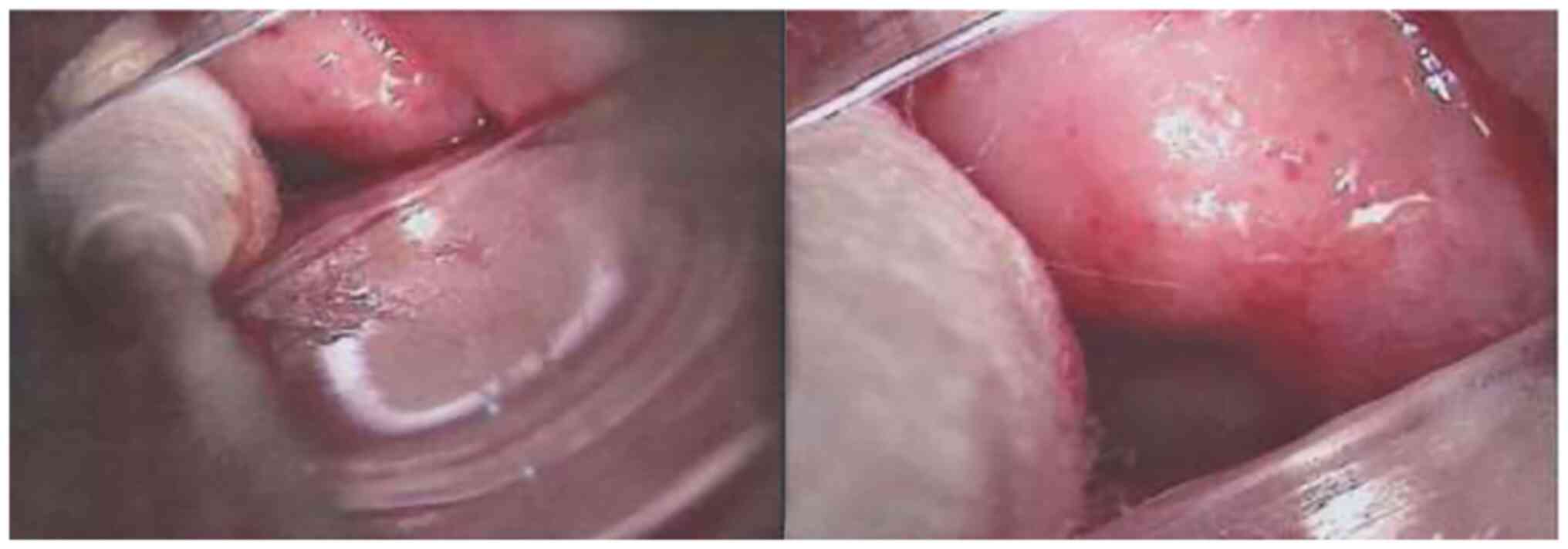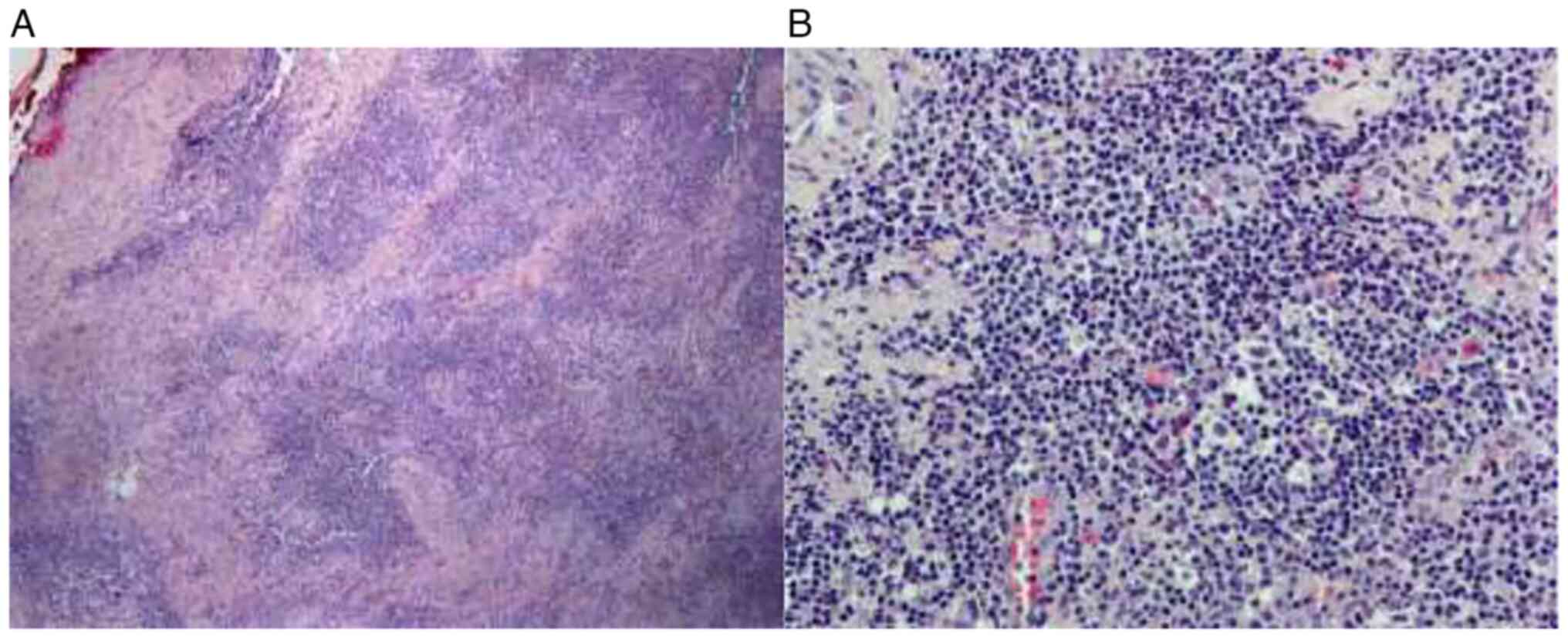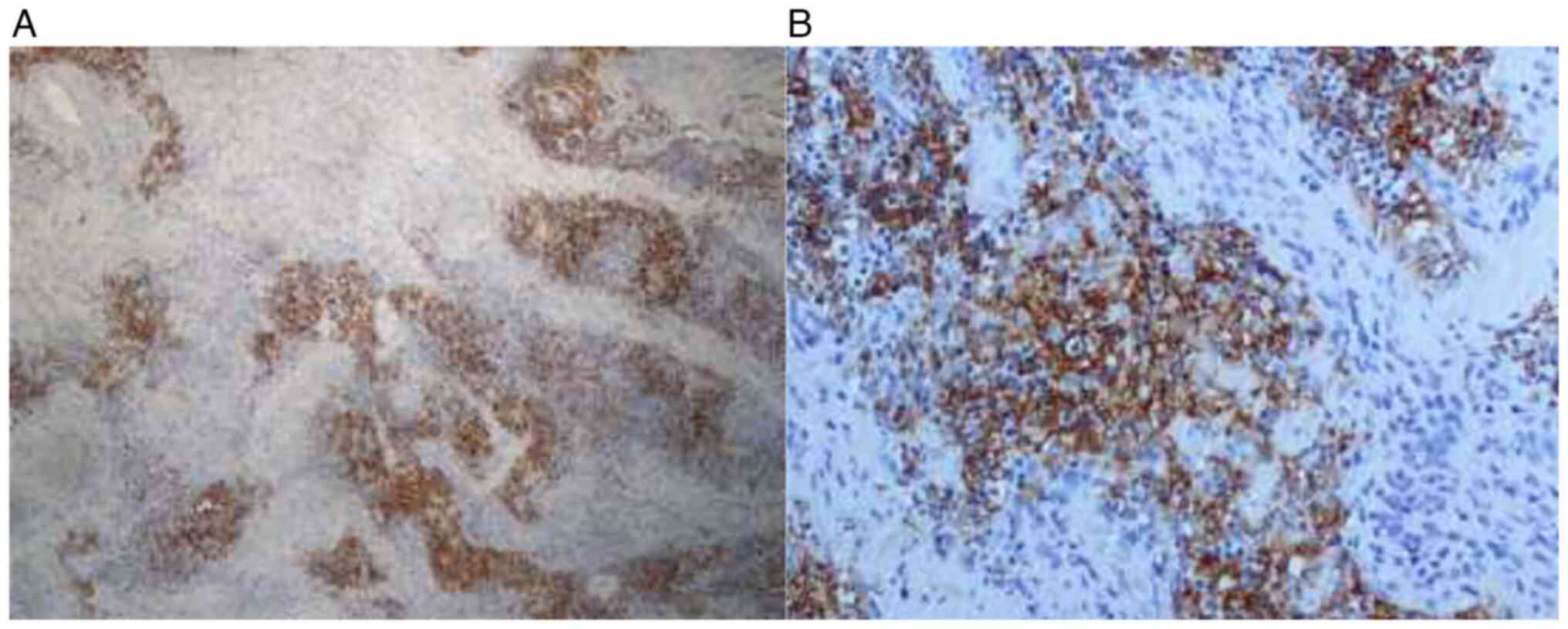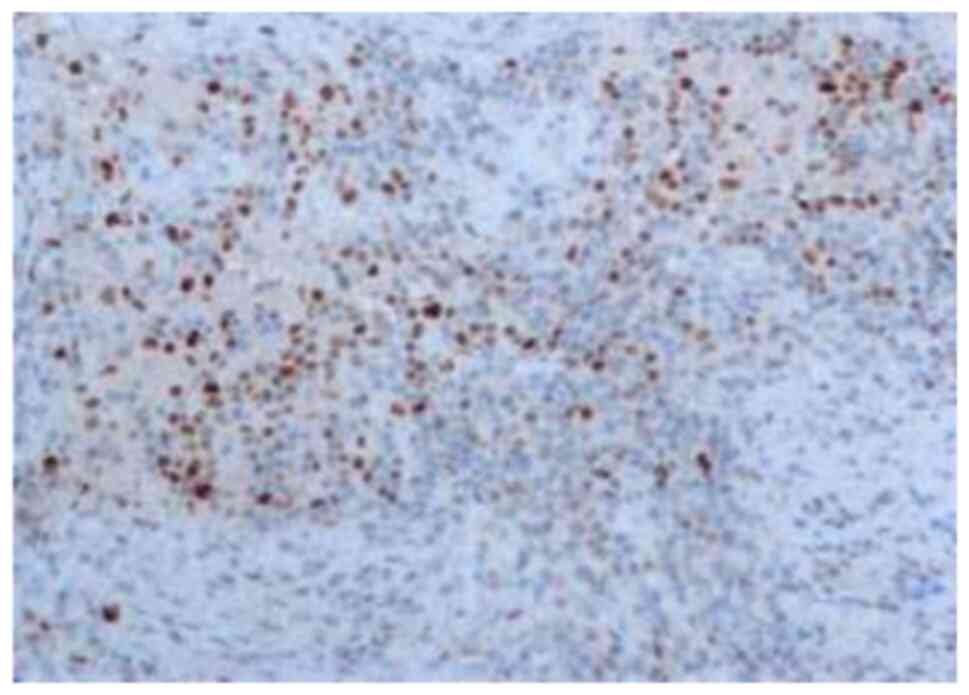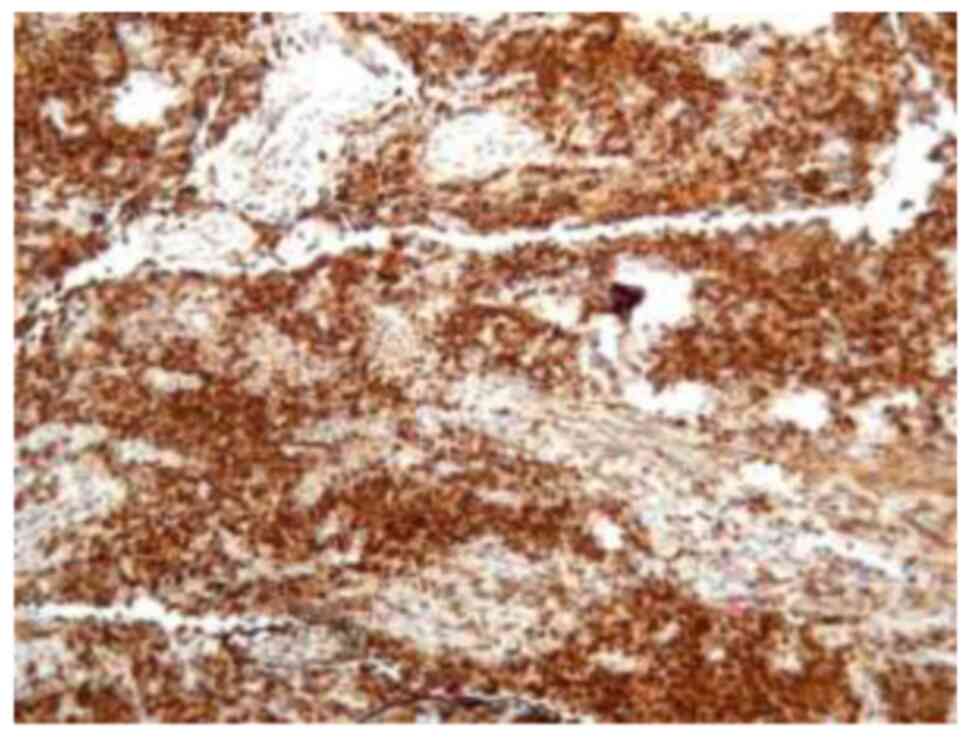Primary follicular lymphoma of the uterine cervix: A case report
- Authors:
- Published online on: April 26, 2023 https://doi.org/10.3892/ol.2023.13837
- Article Number: 251
-
Copyright: © Matsas et al. This is an open access article distributed under the terms of Creative Commons Attribution License.
Abstract
Introduction
Primary lymphomas of the uterine cervix are rare, accounting for 0.5-1% of all extranodal Non-Hodgkin's Lymphomas (NHL) (1). Even less common are primary cervical lymphomas of the follicular subtype, comprising 8.5% of all primary cervical NHLs (2). The most common presenting symptom is abnormal vaginal bleeding (2,3). Due to the rarity of the disease, it can be confused with other malignancies, such as squamous cell carcinoma or inflammatory processes. There is no established therapeutic protocol. Thus, different approaches, including surgery, radiotherapy and chemotherapy (either alone or in combination), are often employed (3). Herein, we present a rare case of primary cervical follicular lymphoma that was managed surgically.
Case report
The patient was a 54-year-old, gravida 1 para 1, postmenopausal woman, who presented for her annual gynecological check-up without any symptoms. The patient had a history of rheumatoid arthritis, Crohn's disease, primary biliary cirrhosis, pulmonary fibrosis, nodular goiter and hemophilia (Factor XI=41%) and was being treated with methotrexate, ursodeoxycholic acid, and levothyroxine. During a routine Papanicolaou smear test, cytology revealed numerous dysplastic cells with possible koilocytic atypia and dyskeratosis, characterized initially as Cervical Intraepithelial Neoplasia (CIN) I–II owing to human papillomavirus (HPV) infection. Transvaginal ultrasonography (TVUS) showed a thickened, barrel-shaped cervix with a diameter of 2 cm and widespread hyperechogenicity. The patient subsequently underwent colposcopy, during which significant vaginal atrophy and stenosis along with a friable ectocervical mucosa was noted (Fig. 1).
The patient was admitted to the Second Department of Obstetrics and Gynecology at Aretaieio University Hospital (Athens, Greece) in February 2020. A wide surgical biopsy was performed and the histopathological results were consistent with the diagnosis of non-Hodgkin B-cell follicular lymphoma (Grade 1/2). Under microscopical examination, the normal architecture of the lymph node was effaced due to the presence of multiple nodular formations (Fig. 2) mimicking secondary follicles with expanded ‘follicle-centers’, but with loss of polarity, absence of macrophages and therefore loss of the ‘starry-sky’ pattern which characterizes normal follicles. The cellular composition of the nodules included centrocytes and scattered centroblasts (the latter not exceeding 6 per ten high power fields), with an immunophenotype: CD20+ (Fig. 3), CD23+ (Fig. 4), bcl-6+ (Fig. 5), bcl-2+ (Fig. 6), CD5-, Cyclin D1-. Notably cells with similar morphologic and immunophenotyping features were found outside the nodules, either singly or in aggregates. The Ki67 labeling index was 15% (Fig. 7), allowing for the diagnosis of classical follicular lymphoma (according to the new, 2022, 5th edition of the World Health Organization Classification of Haematolymphoid Tumours). The resection margins were positive. A computed tomography scan of the thorax and the abdominal cavity showed no lymphadenopathy or hepatosplenomegaly and the patient was staged as Ann Arbor IEA. The patient was evaluated by a hematologist who suggested treatment with rituximab. However, due to intolerable side effects, the treatment was discontinued and the patient was scheduled for cervical conization under general anesthesia. The resection margins of the specimen were negative and no further treatment took place. After 2 years of close follow-up monitoring, the patient has no evidence of disease.
Discussion
Follicular lymphoma is the second most common type of primary female genital tract non-Hodgkin lymphoma, after diffuse large-B-cell lymphoma (4,5), which according to the new, 5th edition of the World Health Organization Classification of Haematolymphoid Tumours is no longer mandatory for classification purposes (6). The diagnostic algorithm encompasses architecture, morphology/cellular composition, and immunophenotypic features of the neoplastic B-lymphocytes such as expression of CD10, BCL-2 and BCL-6 (7), while molecular techniques which detect the t (14;18) translocation involving the IgH/bcl-2 genes are not required for the diagnosis and are used only in equivocal cases. Detectable monoclonal immunoglobulin expression by the neoplastic cells is not a regular feature of follicular lymphoma (in contrast with marginal zone lymphoma), although is sometimes described in rare cases, posing for differential diagnosis with marginal zone derivation lymphomas.
Clinical manifestations of primary cervical lymphomas are abnormal vaginal bleeding, abdominal/pelvic discomfort, dyspareunia, vaginal discharge and less often, back pain (3). The definitive diagnosis of cervical non-Hodgkin lymphoma is not possible using Pap smear testing alone, as the tumor originates in the stroma, often leaving the overlying squamous epithelium unaffected (8). Nonetheless, the disease can coexist with cytological abnormalities. Cervical biopsy and immunophenotyping is necessary to distinguish primary NHLs of the uterine cervix from other malignant and inflammatory diseases.
For the staging of cervical lymphomas, both the Ann Arbor system and the International Federation of Gynecology and Obstetrics (FIGO) system have been used, with few studies claiming superior sensitivity of the Ann Arbor system (9). For the assessment of patient prognosis, the Follicular Lymphoma International Prognostic Index (FLIPI) can be utilized. Taking into account five ‘poor’ prognostic factors, namely: age >60 years, hemoglobin <12 g/dl, serum lactate dehydrogenase (LDH) higher than normal, Ann Arbor stage III/IV and number of involved nodal areas >4, the risk of death can be estimated. Having 0–1 risk factors places a patient at ‘low’ risk, 2–3 risk factors at ‘intermediate’ risk and 4–5 at ‘high’ risk (10). Our patient, having had no risk factors, was considered to be of low risk.
There is no established protocol for the treatment of primary cervical non-Hodgkin lymphomas. Treatment options include chemotherapy, radiotherapy and surgery, either alone or in combination, while for recurrent disease, immunotherapy and stem cell transplantation can also be employed (11). For early-stage follicular lymphoma patients, watchful waiting can be an acceptable approach without deleterious effects on the patients' overall survival (12). Regardless, most patients receive CHOP chemotherapy (cyclophosphamide, doxorubicin, vincristine, and prednisone) with or without rituximab (13). Rituximab, an anti-CD20 monoclonal antibody, can be used in the CD20(+) primary lymphomas of the cervix, either combined with chemotherapy or as monotherapy, with significant response rates and a relatively favorable side effect profile (14). Since the introduction of rituximab, the overall survival of patients with follicular lymphoma has improved drastically (15). For localized pelvic disease, radiotherapy alone can be employed due to high response rates and low morbidity (13). In some cases of cervical lymphomas, surgery can be an acceptable and effective approach (3,7).
In conclusion, primary cervical follicular lymphoma is a rare malignancy, without an established therapeutic protocol. Surgery, chemotherapy and radiotherapy, either alone or in combination, have been proposed as possible therapeutical options. In the case of our patient, the disease was limited to the uterine cervix without regional expansion or metastasis. The patient was managed primarily by surgery and 2 years later remains without evidence of disease recurrence. Although quite rare, clinicians and pathologists should consider lymphomas of the female genital tract as a possible diagnosis, when dealing with pathologies of the female genital tract. By avoiding misdiagnosis, they can provide the patient with the best possible therapeutic interventions.
Acknowledgements
Not applicable.
Funding
Funding: No funding was received.
Availability of data and materials
The datasets used and/or analyzed during the current study are available from the corresponding author on reasonable request.
Authors' contributions
TP and AM were involved in project development, data collection and management, data analysis and manuscript writing. PC, CK and NV were involved in project development, data collection and management, data analysis and manuscript editing. OS and LM reviewed and prepared the case's histopathological reports. AM and CK confirm the authenticity of all the raw data. All authors read and approved the final manuscript.
Ethics approval and consent to participate
The patient provided written informed consent for participation.
Patient consent for publication
The patient provided written informed consent for the publication of all relevant data and accompanying images.
Competing interests
The authors declare that they have no competing interests.
Glossary
Abbreviations
Abbreviations:
|
NHL |
non-Hodgkin lymphoma |
|
CIN |
cervical intraepithelial neoplasia |
|
TVUS |
transvaginal ultrasound |
|
FLIPI |
Follicular Lymphoma International Prognostic Index |
|
HPV |
human papillomavirus |
|
LDH |
lactate dehydrogenase |
References
|
Freeman C, Berg JW and Cutler SJ: Occurrence and prognosis of extranodal lymphomas. Cancer. 29:252–260. 1972. View Article : Google Scholar : PubMed/NCBI | |
|
Korcum AF, Karadogan I, Aksu G, Aralasmak A and Erdogan G: Primary follicular lymphoma of the cervix uteri: A review. Ann Hematol. 86:623–630. 2007. View Article : Google Scholar : PubMed/NCBI | |
|
Perren T, Farrant M, McCarthy K, Harper P and Wiltshaw E: Lymphomas of the cervix and upper vagina: A report of five cases and a review of the literature. Gynecol Oncol. 44:87–95. 1992. View Article : Google Scholar : PubMed/NCBI | |
|
Kosari F, Daneshbod Y, Parwaresch R, Krams M and Wacker HH: Lymphomas of the female genital tract: A study of 186 cases and review of the literature. Am J Surg Pathol. 29:1512–1520. 2005. View Article : Google Scholar : PubMed/NCBI | |
|
Swerdlow SH, Campo E, Pileri SA, Harris NL, Stein H, Siebert R, Advani R, Ghielmini M, Salles GA, Zelenetz AD and Jaffe ES: The 2016 revision of the World Health Organization classification of lymphoid neoplasms. Blood. 127:2375–2390. 2016. View Article : Google Scholar : PubMed/NCBI | |
|
Polyatskin IL, Artemyeva AS and Krivolapov YA: Revised WHO classification of tumors of hematopoietic and lymphoid tissues, 2017 (4th edition): lymphoid tumors. Arkh Patol. 81:59–65. 2019.(In Russian). View Article : Google Scholar : PubMed/NCBI | |
|
Freedman A and Jacobsen E: Follicular lymphoma: 2020 Update on diagnosis and management. Am J Hematol. 95:316–327. 2020. View Article : Google Scholar : PubMed/NCBI | |
|
Dursun P, Gultekin M, Bozdag G, Usubutun A, Uner A, Celik NY, Yuce K and Ayhan A: Primary cervical lymphoma: Report of two cases and review of the literature. Gynecol Oncol. 98:484–489. 2005. View Article : Google Scholar : PubMed/NCBI | |
|
Lagoo AS and Robboy SJ: Lymphoma of the female genital tract: Current status. Int J Gynecol Pathol. 25:1–21. 2006. View Article : Google Scholar : PubMed/NCBI | |
|
Solal-Céligny P, Roy P, Colombat P, White J, Armitage JO, Arranz-Saez R, Au WY, Bellei M, Brice P, Caballero D, et al: Follicular lymphoma international prognostic index. Blood. 104:1258–1265. 2004. View Article : Google Scholar : PubMed/NCBI | |
|
Mann R, Roberts WS, Gunasakeran S and Tralins A: Primary lymphoma of the uterine cervix. Gynecol Oncol. 26:127–134. 1987. View Article : Google Scholar : PubMed/NCBI | |
|
Advani R, Rosenberg SA and Horning SJ: Stage I and II follicular non-Hodgkin's lymphoma: Long-term follow-up of no initial therapy. J Clin Oncol. 22:1454–1459. 2004. View Article : Google Scholar : PubMed/NCBI | |
|
Hilal Z, Hartmann F, Dogan A, Cetin C, Krentel H, Schiermeier S, Schultheis B and Tempfer CB: Lymphoma of the cervix: Case report and review of the literature. Anticancer Res. 36:4931–4940. 2016. View Article : Google Scholar : PubMed/NCBI | |
|
Ardeshna KM, Qian W, Smith P, Braganca N, Lowry L, Patrick P, Warden J, Stevens L, Pocock CF, Miall F, et al: Rituximab versus a watch-and-wait approach in patients with advanced-stage, asymptomatic, non-bulky follicular lymphoma: An open-label randomised phase 3 trial. Lancet Oncol. 15:424–435. 2014. View Article : Google Scholar : PubMed/NCBI | |
|
Junlén HR, Peterson S, Kimby E, Lockmer S, Lindén O, Nilsson-Ehle H, Erlanson M, Hagberg H, Rådlund A, Hagberg O and Wahlin BE: Follicular lymphoma in Sweden: Nationwide improved survival in the rituximab era, particularly in elderly women: A Swedish lymphoma registry study. Leukemia. 29:668–676. 2015. View Article : Google Scholar : PubMed/NCBI |



